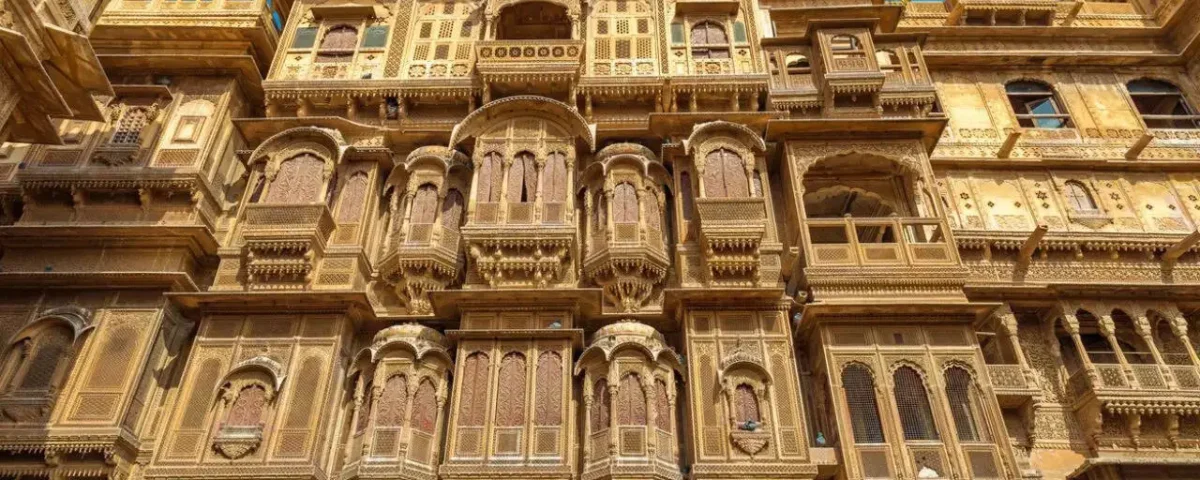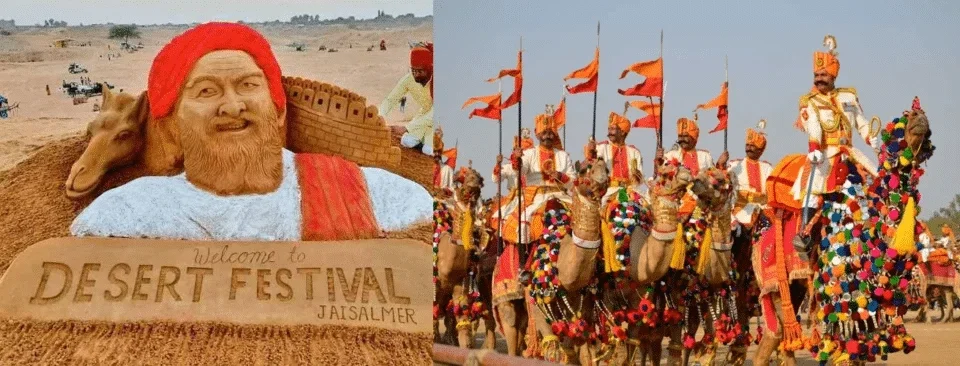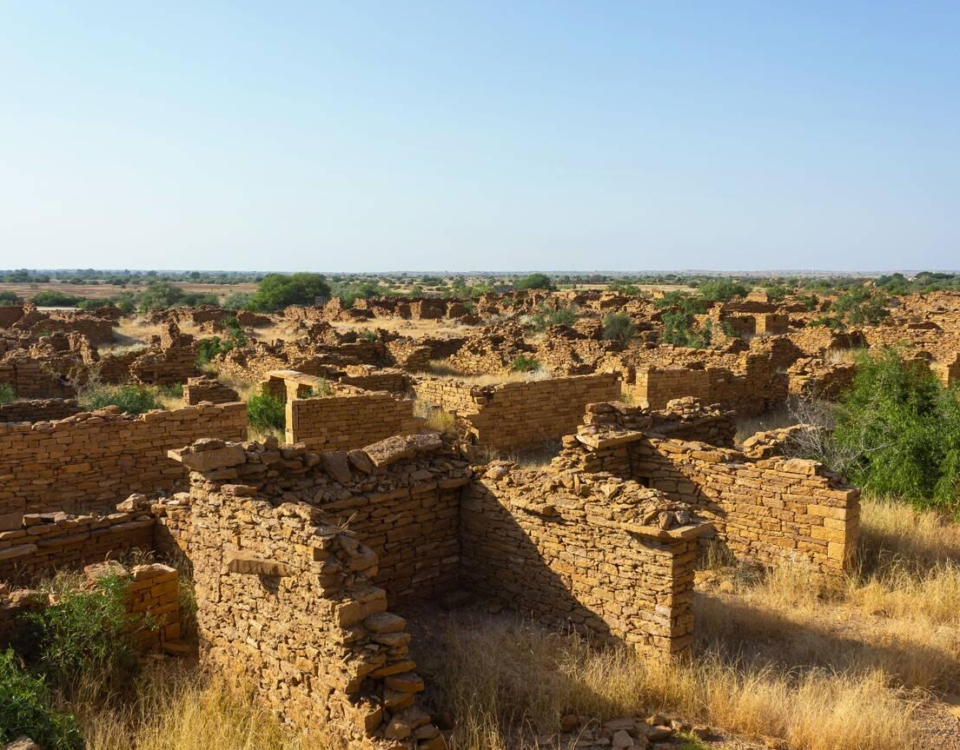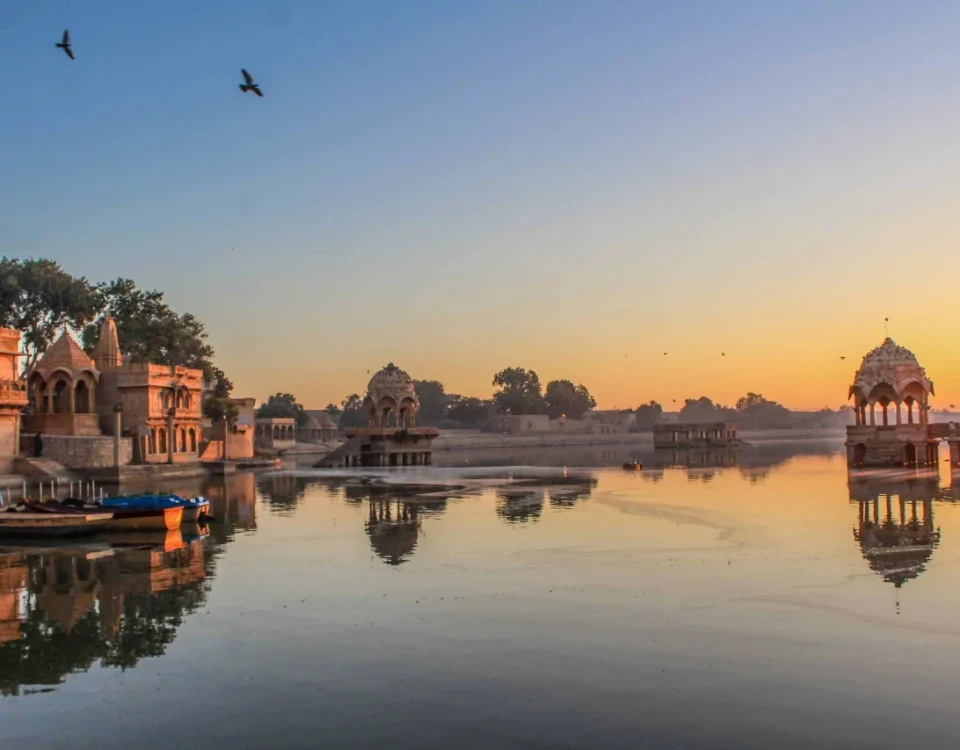- Best Tour & Travels Company In All Over Jaisalmer
- +91-9782984399
- +91-7240531663
- jaisalmertourandtravel@gmail.com
Patwa Haveli Jaisalmer Guide: History, Timings, and Distance from Jaisalmer Fort

Maru Mahotsav Jaisalmer 2026 – A Complete Guide
November 7, 2025Introduction – The Grandeur of Patwa Haveli Jaisalmer
The Patwa Haveli Jaisalmer stands as one of the most magnificent examples of Rajasthani architecture, radiating unmatched beauty in the heart of the Golden City. Its golden façade, carved from the same yellow sandstone that gives Jaisalmer its nickname, glows warmly under the desert sun. Every inch of Patwa Haveli Jaisalmer reflects craftsmanship at its finest—intricate balconies, detailed jharokhas, and walls adorned with traditional motifs that showcase the skill of Jaisalmer’s artisans.
Often called Patwa ki Haveli, this architectural marvel isn’t just a building—it’s a timeless reflection of Jaisalmer’s glorious past. Built in the 19th century by the wealthy merchant Guman Chand Patwa for his five sons, the haveli complex includes five separate mansions, each grander than the last. Together, they symbolize the prosperity and influence of the Patwa family, who were among Jaisalmer’s most successful traders. The lavish interiors of Patwa ki Haveli—filled with mirror work, murals, and antique furnishings—still echo the luxury of that golden era.
Today, Patwa Haveli Jaisalmer stands as a living museum, giving visitors a glimpse into the city’s cultural and commercial legacy. From its detailed carvings to panoramic rooftop views, every corner tells a story of opulence and tradition. In this comprehensive Patwa Haveli Jaisalmer guide, you’ll discover its fascinating history, explore its unique architecture, learn about Patwa Haveli timings, and understand its distance from Jaisalmer Fort, one of Rajasthan’s most famous landmarks.
Whether you call it Patwa ki Haveli or Patwa Haveli Jaisalmer, one thing remains certain—it’s an unmissable stop for anyone who wants to truly experience the golden grandeur of Jaisalmer.
Patwa Haveli Jaisalmer History – A Merchant’s Dream in Stone
The Patwa Haveli Jaisalmer history is a fascinating tale of ambition, artistry, and wealth woven into sandstone. Built in the early 19th century by Guman Chand Patwa, one of Jaisalmer’s richest merchants, this architectural masterpiece represents both his prosperity and vision. Guman Chand Patwa was a successful trader dealing in gold, silver, and fine textiles, and his dream was to create a residence that reflected not just luxury but legacy—a symbol of the Patwa family’s prominence in Jaisalmer’s thriving trade era.
The result was the grand Patwa ki Haveli Jaisalmer, a cluster of five magnificent havelis built for his five sons. Each haveli stands side by side, forming a seamless yet distinct architectural harmony. Together, they earned the collective name “Patwon ki Haveli,” meaning “the mansions of the Patwas.” This cluster became one of the most impressive residential complexes in Rajasthan, admired for its opulence and intricate craftsmanship that still captivates visitors today.
The Patwa Haveli Jaisalmer history is not only about wealth but also about the artistic fusion of styles. The haveli’s design beautifully blends Rajput and Mughal architectural influences—Rajput strength seen in its solid stone structure and Mughal grace reflected in the delicate carvings, arches, and latticework. The façades are adorned with ornamental balconies, intricate motifs, and finely carved pillars that seem to defy time. Inside, you’ll find murals depicting traditional Rajasthani life, mirror work that sparkles under natural light, and frescoes that narrate stories of culture and celebration.
A lesser-known anecdote in Patwa ki Haveli Jaisalmer history is that despite its grandeur, the Patwa family never permanently lived here. Their business eventually shifted outside Jaisalmer, and the haveli later came under the care of government and private custodians. Today, part of the haveli has been converted into a museum that showcases antique artifacts, royal costumes, and traditional household items, giving visitors a real sense of how life once unfolded within these golden walls.
Exploring the Patwa ki Haveli Jaisalmer is like stepping into a time capsule of Rajasthan’s golden age—where every corridor whispers tales of trade, tradition, and timeless artistry. For anyone seeking to understand the cultural and historical depth of Jaisalmer, the Patwa Haveli Jaisalmer history stands as a perfect testament to the city’s legacy of elegance and endurance.
Exploring the Architecture and Interiors of Patwa Ki Haveli
The first thing that captures your eye when you approach Patwa ki Haveli is its sheer grandeur. Rising from Jaisalmer’s narrow golden lanes, the haveli’s façade looks like it’s been sculpted rather than built. Every inch of the Patwa Haveli Jaisalmer exterior is covered with carvings—balconies that seem to float in air, windows framed with lace-like sandstone patterns, and arches detailed with motifs that speak of royal craftsmanship. The artistry here is so precise that even the smallest floral designs feel alive, as if the stone itself was breathing history.
The Patwa ki Haveli complex, with its five adjoining mansions, showcases a perfect blend of luxury and local tradition. The haveli’s ornate balconies—known as jharokhas—are masterpieces in themselves, designed for both ventilation and aesthetics. When sunlight filters through these jharokhas, it paints intricate shadows on the walls and floors, giving the interiors a warm, golden glow that shifts beautifully throughout the day.
Inside, the Patwa Haveli Jaisalmer is just as mesmerizing. The haveli houses a well-preserved museum displaying antique furniture, traditional costumes, royal artifacts, and handcrafted jewelry that once belonged to the Patwa family. The museum rooms have been carefully maintained to preserve their authenticity—mirror-studded ceilings reflect faint light like stars, hand-painted murals adorn every wall, and antique wooden doors creak with the weight of time. The air itself feels different—cool, heavy with history, and faintly scented with the earthiness of aged stone.
Each room in Patwa ki Haveli tells a story. Some walls depict scenes from Rajasthani folklore, while others celebrate moments of royal life—musicians playing sitars, dancers frozen mid-step, and merchants counting coins of gold. The craftsmanship is so fine that you can almost feel the devotion that went into each carving. As you walk through narrow corridors and spiral staircases, you’re not just exploring architecture—you’re walking through centuries of legacy preserved in golden stone.
Whether it’s the way light dances on the sandstone or the echo of footsteps across its timeworn floors, Patwa Haveli Jaisalmer embodies the soul of desert artistry. It stands as a living museum of Jaisalmer’s golden past—a place where history doesn’t just survive, it speaks.
Patwon Ki Haveli Timings and Entry Fees
Before planning your visit, it’s important to know the Patwon ki Haveli timings, entry fees, and a few essential visitor details. The haveli operates as both a heritage site and a museum, giving visitors a chance to explore its art, history, and architecture at their own pace.
Here’s a quick overview for easy reference:
| Details | Information |
|---|---|
| Patwon Ki Haveli Timings | 9:00 AM to 5:00 PM (Open all days of the week) |
| Entry Fee (Indian Visitors) | ₹30 – ₹50 per person (varies by section/museum) |
| Entry Fee (Foreign Visitors) | ₹100 – ₹150 per person |
| Camera Fee | ₹50 for still camera; ₹100 for video camera (approx.) |
| Guide Availability | Local guides available at the entrance; recommended for deeper historical insights |
| Location | Near Amar Sagar Pol, Jaisalmer Fort Road, Jaisalmer, Rajasthan |
The Patwon ki Haveli timings are ideal for morning or late-afternoon visits when the sunlight enhances the golden hue of the sandstone. Visiting early helps you avoid crowds and gives you more time to appreciate the carvings, courtyards, and museum displays at leisure.
Photography enthusiasts will love capturing the fine details of Patwa Haveli Jaisalmer, but note that there may be a small camera fee for both still and video devices. Local guides, often fluent in multiple languages, are available on-site and can bring the history of Patwon ki Haveli to life with fascinating stories and cultural context.
If you’re planning to explore multiple attractions nearby, it’s good to allocate at least 1–1.5 hours for a complete visit to Patwa Haveli Jaisalmer, including its museum sections.
Snippet for Google Rich Result Optimization:
What are the timings for Patwon Ki Haveli Jaisalmer?
The Patwon ki Haveli timings are from 9:00 AM to 5:00 PM, open every day. Visitors can explore the museum, architecture, and heritage displays during these hours.
Jaisalmer Fort to Patwon Ki Haveli Distance and How to Reach
The Jaisalmer Fort to Patwon ki Haveli distance is approximately 1 kilometer, making it one of the most convenient and rewarding short trips within the city. Both landmarks lie in the heart of Jaisalmer’s old town, surrounded by narrow, golden lanes filled with local shops, cafes, and centuries-old architecture that perfectly capture the charm of Rajasthan’s Golden City.
For most travelers, the best way to cover the Jaisalmer Fort to Patwon ki Haveli distance is on foot. The walk takes around 10 to 15 minutes, and along the way, you can enjoy the rhythm of local life—artisans carving souvenirs, women dressed in colorful attire, and children playing in the bylanes that wind through the sandstone maze. Walking also allows you to stop by smaller attractions like Tilon ki Pol and Nathmal ki Haveli, both located nearby.
If you prefer a more relaxed option, local auto-rickshaws and cycle rickshaws are readily available near the fort’s entrance. The ride costs around ₹50–₹100 depending on the season and time of day. For visitors coming from farther parts of Jaisalmer, cabs and e-rickshaws are also a convenient choice—especially if you’re traveling with family or during the hotter hours of the day.
Travel Tip: The route from Jaisalmer Fort to Patwa Haveli Jaisalmer passes through some of the most picturesque streets of the city. Early mornings and late afternoons are the best times to go, as the golden hue of the sandstone glows beautifully under the soft light, making for incredible photos.
You can easily locate directions using Google Maps—just search for Patwon Ki Haveli Jaisalmer, and you’ll get the shortest walking or driving route with real-time traffic updates. Given the close Jaisalmer Fort to Patwon ki Haveli distance, exploring both sites on the same day is not only practical but one of the best ways to experience Jaisalmer’s heritage at its finest.
Best Time to Visit Patwa Ki Haveli Jaisalmer
The best time to visit Patwa Ki Haveli is during the early mornings or late afternoons, when the golden sunlight enhances the intricate carvings and creates a magical glow across the sandstone façade. In the morning, the lanes are peaceful, making it ideal for photographers and history lovers who wish to explore the Patwa ki Haveli Jaisalmer without the rush of tourist crowds. By late afternoon, as the sun begins to set, the haveli shines in warm amber tones—perfect for those looking to experience its charm in a calm, ambient atmosphere.
From a seasonal perspective, the best time to visit Patwa Ki Haveli is between October and February, when Jaisalmer enjoys its most pleasant weather. The winter months offer cool breezes and clear skies, allowing you to walk through the old city comfortably and spend time exploring every corner of the haveli without the harsh desert heat. During these months, you can also attend the famous Desert Festival, which adds cultural vibrancy to your visit.
Avoid peak summer (April to June), as temperatures can rise above 40°C, making exploration tiring. However, if you visit during the monsoon (July to September), you’ll see a quieter side of Jaisalmer, with fewer tourists and softer hues over the Patwa Haveli Jaisalmer architecture.
In short, the best time to visit Patwa Ki Haveli combines good lighting, fewer crowds, and pleasant weather—ensuring you truly experience the essence of this golden-era masterpiece.
Things to Do Near Patwa Haveli
After exploring the grandeur of Patwa Haveli Jaisalmer, you’ll find plenty of nearby attractions and local experiences to enrich your trip. Within walking distance, you can visit other iconic havelis like Nathmal Ki Haveli, known for its symmetrical carvings crafted by two brothers, and Salim Singh Ki Haveli, famous for its peacock-shaped arches and unique architecture. These sites together form Jaisalmer’s triad of heritage mansions, offering a deep insight into the city’s royal and merchant history.
If you’re planning to explore further, the majestic Jaisalmer Fort is just about a kilometer away. Its narrow lanes, historic temples, and stunning viewpoints make it a must-visit destination. You can easily reach these places using a local cab or book a Jaisalmer Taxi Service for a comfortable and guided experience around the city.
For those who enjoy café-hopping or local shopping, the area surrounding Patwa ki Haveli has some charming rooftop cafés offering panoramic fort views and traditional Rajasthani snacks. The Manak Chowk Bazaar nearby is perfect for picking up souvenirs, handicrafts, and mirror-work textiles that showcase Jaisalmer’s artistry.
If you want to make the most of your heritage tour, you can book a Jaisalmer Sightseeing Taxi to cover multiple attractions in one go, including the havelis, fort, Gadisar Lake, and local markets.
Whether you’re strolling through ancient lanes, sipping chai on a rooftop, or capturing golden sunsets, the area around Patwa Haveli Jaisalmer ensures that every moment feels like a journey through time.
Photography and Local Culture at Patwa Haveli
If there’s one place in the Golden City that defines photogenic perfection, it’s Patwa Haveli Jaisalmer. Every corner of this architectural gem feels like a frame waiting to be captured—the carved jharokhas, sandstone balconies, and latticed windows reflect the golden light so beautifully that even amateur photographers come away with postcard-worthy shots. Early mornings and late afternoons are when Patwa ki Haveli glows the brightest, as the sunlight hits the façade at a soft angle, revealing the intricate carvings and fine details etched into every inch of stone.
The Patwa Haveli Jaisalmer interiors offer endless photography opportunities. The museum’s mirror-adorned rooms, antique furniture, and frescoed walls provide stunning textures and patterns for close-up shots. You can also capture the play of light and shadow that filters through carved windows, giving the haveli an ethereal look that changes throughout the day. The courtyards, with their rustic charm and ornate pillars, are perfect for architectural compositions.
Step outside, and you’ll find the vibrant local culture surrounding Patwa ki Haveli equally captivating. The streets buzz with artisans selling handcrafted jewelry, embroidered textiles, and miniature souvenirs inspired by Jaisalmer’s royal heritage. Locals dressed in traditional Rajasthani attire often add color and authenticity to every photo, while musicians occasionally fill the air with the sound of folk tunes. For the best candid shots, interact with the locals respectfully—they often welcome travelers who appreciate their craft.
Photography Tips for Patwa Haveli Jaisalmer:
- Visit during early morning (8–9 AM) or late afternoon (4–5 PM) for the best natural lighting.
- Carry a wide-angle lens to capture the full façade and intricate carvings.
- Use the sandstone’s golden tone as a natural filter for warm, rich images.
- Be mindful of restricted areas inside the museum where photography may not be allowed.
Whether you’re shooting on a DSLR or a smartphone, Patwa Haveli Jaisalmer promises visuals that embody the essence of Rajasthan’s art and heritage in every frame.
Muvera’s Travel Tips for Exploring Jaisalmer’s Heritage
When exploring Patwa Haveli Jaisalmer, comfort, timing, and local insight can make all the difference between a rushed visit and a memorable experience. Here are some Patwa Haveli Jaisalmer travel tips curated by Muvera’s on-ground experts, who have explored every corner of this heritage site and its surroundings.
1. Wear Comfortable Footwear:
The narrow lanes and uneven stone paths around Patwa ki Haveli can be tricky to navigate, so comfortable shoes or sandals are a must. Avoid heels or flip-flops, especially if you plan to explore nearby havelis and markets on foot.
2. Hire a Local Guide:
For those genuinely interested in history and architecture, hiring a certified local guide is one of the best Patwa Haveli Jaisalmer travel tips. Guides can explain the historical significance of each haveli, share fascinating merchant stories, and help you understand the symbolism behind the carvings—details often missed by solo visitors.
3. Best Time for Photography:
Muvera’s travel specialists recommend visiting Patwa Haveli Jaisalmer between 8:00 AM and 10:00 AM, or just before sunset. The lighting during these hours gives the sandstone walls their most captivating golden hue—perfect for photos and peaceful exploration.
4. Carry Water and Essentials:
Jaisalmer’s dry climate can be intense even in winter, so it’s wise to carry a bottle of water, sunscreen, and sunglasses. Keeping yourself hydrated ensures you enjoy the haveli and nearby attractions without fatigue.
5. Respect Local Customs:
Remember that Patwa ki Haveli is not just a tourist site—it’s part of Jaisalmer’s living heritage. Avoid touching delicate carvings or leaning on structures, and always ask permission before photographing locals.
6. Explore Beyond the Haveli:
One of Muvera’s most valuable Patwa Haveli Jaisalmer travel tips is to combine your visit with nearby attractions like Salim Singh ki Haveli, Nathmal ki Haveli, and Gadisar Lake for a full heritage circuit. This not only enriches your understanding of the city’s artistry but also gives you a deeper appreciation of Jaisalmer’s cultural layers.
According to Muvera’s on-ground experts, experiencing Patwa Haveli Jaisalmer isn’t about rushing through—it’s about pausing long enough to let the stories in the walls speak to you. With the right planning, timing, and a curious eye, you’ll leave not just with stunning photographs but with a genuine connection to the heart of Jaisalmer’s golden history.
Conclusion – Step into Jaisalmer’s Golden Legacy
Visiting Patwa Haveli Jaisalmer is more than just a walk through an ancient mansion—it’s a journey through time. Every wall, carving, and corridor tells a story of the city’s glorious past, where trade, art, and architecture blended seamlessly to create a golden legacy that still shines today. From its intricate façades and mirror-studded rooms to the vibrant life bustling around it, Patwa ki Haveli captures the soul of Jaisalmer in a way few places can.
The beauty of Patwa Haveli Jaisalmer lies not only in its craftsmanship but in the way it connects you to the essence of Rajasthan—its warmth, artistry, and cultural pride. Whether you’re admiring the delicate jharokhas in the soft morning light or exploring nearby havelis and bazaars, every moment spent here feels like stepping into a living museum of desert heritage.
As you conclude your visit, remember that this is just one chapter of Jaisalmer’s magnificent story. To truly experience the city’s charm—its forts, lakes, dunes, and traditions—explore more of Muvera’s Jaisalmer Travel Guides. Each guide is crafted with local expertise and on-ground insights, helping you uncover hidden gems, authentic experiences, and timeless memories across the Golden City.
Step into history, walk through art, and let Muvera be your trusted companion in discovering the golden legacy of Jaisalmer.




